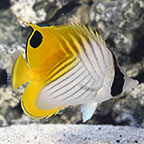Bluefin Damselfish
(Neoglyphidodon melas)

Please Note: Due to variations within species, your item may not look identical to the image provided. Approximate size range may also vary between individual specimen.
Please Note: Due to variations within species, your item may not look identical to the image provided. Approximate size range may also vary between individual specimen.
Bluefin Damselfish
(Neoglyphidodon melas)
Additional locales and sizes may be available!
Additional locales and sizes may be available! Email me when availableQuick Stats
Care Level
Easy
Temperament
Aggressive
Color Form
Black, Blue, Yellow
Diet
Omnivore
Reef Compatible
With Caution
Water Conditions
sg 1.020-1.025, 72-78° F, dKH 8-12, pH 8.1-8.4
Max. Size
7"
Family
Pomacentridae
Minimum Tank Size
50 gallons
What do these Quick Stats mean? Click here for more information
Care Level
Easy
Temperament
Aggressive
Color Form
Black, Blue, Yellow
Diet
Omnivore
Reef Compatible
With Caution
Water Conditions
sg 1.020-1.025, 72-78° F, dKH 8-12, pH 8.1-8.4
Max. Size
7"
Family
Pomacentridae
Minimum Tank Size
50 gallons
What do these Quick Stats mean? Click here for more information
Overview
The Bluefin Damselfish is also called the Black Damselfish, Bowtie Damselfish, Yellow-back Damsel, and Royal Damsel. As a juvenile, it is very attractive, with a gray body highlighted by bright yellow dorsally and blue pectoral fins. As the fish matures, it becomes uniformly black.
In the wild, the Bluefin Damselfish is usually solitary and often associated with soft corals on which it feeds. In the aquarium, the juvenile is generally peaceful but becomes quite aggressive as it matures. It should only be kept with other large aggressive species. Only one Bluefin Damselfish should be kept per aquarium, unless it is very large. It may be a threat to shrimp, and may nip at soft corals.
The Bluefin Damselfish accepts most food including flake and frozen preparations.
Approximate Purchase Size: 1/2" to 1-1/2"
Supplies You May Be Interested In
Customer Testimonials
Elby Davis
Holland , PA
A very personable and lively fish. The Bluefin Damsel will never get boring! I strongly suggest not housing with soft corals as they tend to nip and thus prohibit proliferation.
1-1 of 1 testimonials













